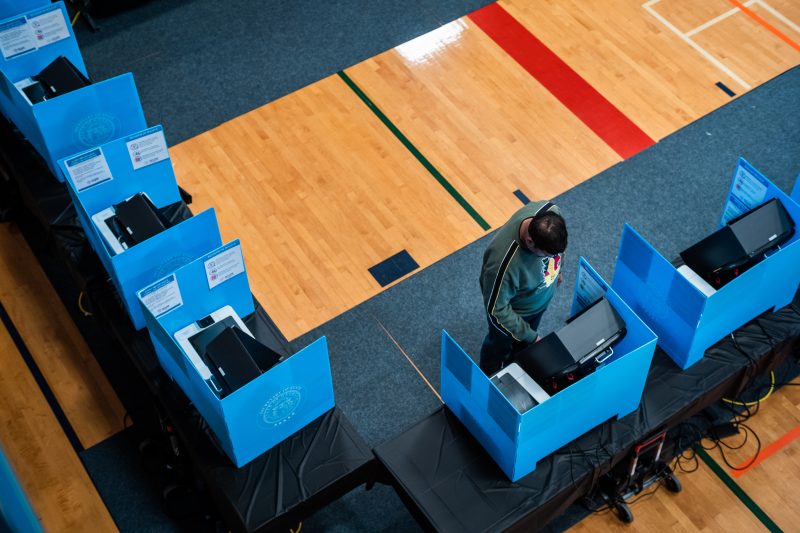The 2022 midterm elections did not go the way the Republican Party expected. Historical patterns suggested that the party would accrue a hefty majority in the House and regain control of the Senate. Those things didn’t happen for a variety of reasons.
But the party can take solace in one thing: The results would probably have been quite a bit worse if the electorate actually looked like the U.S. population.
The Washington Post’s Scott Clement and Lenny Bronner this week looked at new data from the Census Bureau tracking voter participation in the midterms. After adjusting the data to match state-level turnout, they discovered that turnout rates among Black voters declined heavily since the 2018 election.
Turnout rates have an obvious relationship to the composition of the electorate, of course. If White and Black Americans turned out at the same rate, there would still be far more White voters, given the composition of the population. But if White turnout is substantially higher than Black turnout, as it was last year, the gap in representation at the polls is wider still.
In fact, if we compare the composition of the electorate with the composition of the population, that gap is obvious. Looking at the figures on race and age calculated by Clement and Bronner and comparing them to Census Bureau population data, we see that the electorate was much whiter and much older than the population overall.
About 74 percent of the electorate was White, compared with 59 percent of the population. About 41 percent of the electorate was 60 or older, compared with 30 percent of the adult population.
The biggest racial gulf was among Hispanics. About 19 percent of the population is Hispanic, but less than 10 percent of the electorate was. Citizenship plays a role here; Hispanics make up about 16 percent of the population of U.S. citizens.
There’s still a wide gap, in other words — in part because “older” and “whiter” overlap. Younger Americans, a lower-turnout group, are more likely to be non-White, also a lower-turnout group. There are a lot of reasons for both of those tendencies, including that voting is easier for those who own homes or work steady hours and that there are structural roadblocks that inhibit many demographic groups from voting.
The disparity in 2022 wasn’t unique. Whites have been overrepresented in the electorate since they were the only ones allowed to vote. Tracking the trend in representation since 1986, though, we see an interesting pattern: Whites have gotten slightly more overrepresented and Hispanics have gotten more underrepresented.
You can see that below. Each line tracks the percentage of the population and percentage of the electorate each racial group constituted in a federal election year since 1986. The White population percentage has declined, as has the percent of the electorate it makes up. (The 2022 percentages are indicated with a dot.) But that dark-purple line is moving slightly away from the dashed diagonal line over time, as the overrepresentation increases.
In 1985, Whites were overrepresented in the electorate by about eight percentage points. In 2022, it was about 15 points.
That’s in part because Hispanic representation is moving away from the diagonal in the other direction. Hispanics are now underrepresented by twice the margin they were in 1986.
Black Americans are underrepresented relative to the population, but there have been recent exceptions. Since 2008, Blacks have made up about as much of the electorate as they do the population, dipping down again in 2022.
Again, this overlaps with age. The patterns of representation in the population look different largely because of the baby boom, with the population ages 45 to 69 surging and receding in the 1986-to-2023 period. (Each age group is broken out separately in graphs at the bottom, below.) But the gap in representation has been consistent, with older Americans being overrepresented and younger Americans underrepresented.
(That’s only the adult population, mind you. For obvious reasons, those younger than 18 aren’t represented in the electorate at all.)
It’s hard to say precisely how this affects election results, but we can estimate it using exit polls. If we use the turnout data by race (specifically White vs. non-White), we see that Republican House candidates had more votes by a three point margin nationally. If the electorate matched the population, though, those exit polls suggest that Democratic candidates would have had more votes by a five point margin — an eight point swing.
That’s a very rough calculation, comparing White and non-White. If we also do a rough calculation based on age, we go from a three point Republican margin to a less than one point Democratic one, a four point shift to the left. (The exit polls split the 45-and-older population at 65 instead of 60, but partisan support between those groups wasn’t much different.)
As I was writing a book looking at long-term trends in age and race, I interviewed David Faris, an author and professor at Roosevelt University in Chicago.
“The Republican Party’s competitiveness this century has really been propped up by differential turnout rates between younger and older voters,” he said when we spoke in 2021.
Particularly when considering how age and race correlate, 2022 very much bolstered his thesis.
Lenny Bronner and Scott Clement contributed to this report.



























